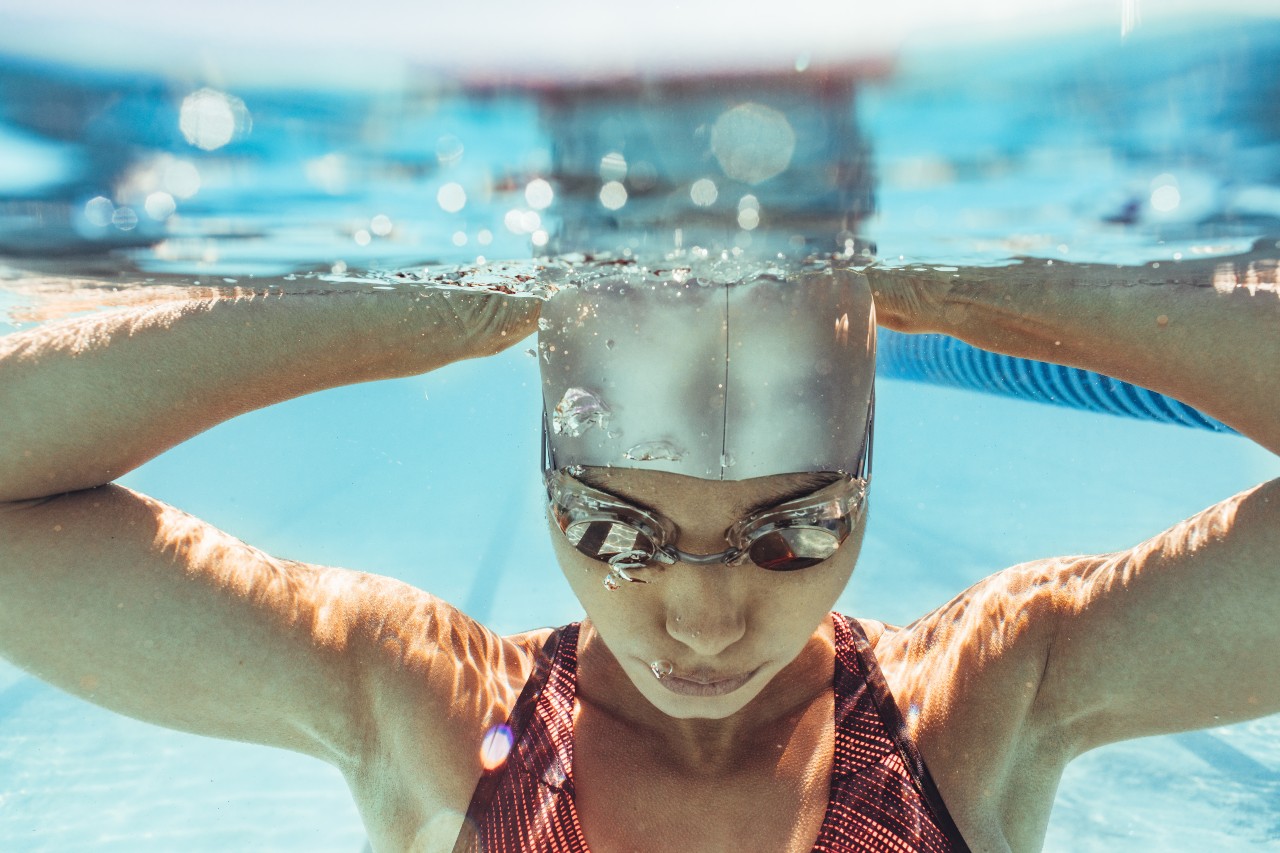A swim cap is an essential piece of equipment for swimmers of all levels. It is a close-fitting, silicone, or latex hat that covers the swimmer’s hair and ears, creating a smooth and hydrodynamic surface that reduces drag in the water.
Swim caps come in a variety of colors and designs and are used for a variety of reasons, including keeping hair out of the swimmer’s face, protecting the hair from the damaging effects of chlorine, and promoting hygiene by preventing the spread of lice and other parasites.
Swim caps are commonly used in competitive swimming, but are also useful for recreational swimmers who want to improve their performance and make their swimming experience more comfortable.
Whether you’re a seasoned pro or just starting out, a swim cap is an essential accessory for any swimmer.
Brief swim cap history
Swim caps have been used by swimmers for over a century. The first swim caps were made of rubber and were used primarily for warmth, as they helped to keep the swimmer’s head and ears warm in cold water. They were also used to keep hair out of the swimmer’s face and to protect hair from the damaging effects of saltwater and chlorine.
In the early 20th century, swim caps became more popular among competitive swimmers as they were found to reduce drag and increase speed in the water. During this time, swim caps were made of a variety of materials, including rubber, latex, and silk.
In the 1960s, swim caps underwent a major transformation with the introduction of synthetic materials, particularly silicone. Silicone swim caps were more durable and resistant to tearing, and they offered a better fit and greater comfort than earlier materials.
Today, swim caps are still an essential piece of equipment for swimmers of all levels, and they are available in a wide range of colors, designs, and materials. While their primary purpose is to reduce drag and improve performance, they also serve other important functions, such as protecting the hair and scalp from the damaging effects of chlorine and promoting hygiene by preventing the spread of lice and other parasites.

Why do you need a swim cap?
There are several reasons why you might need a swim cap when swimming, whether you’re a competitive swimmer or a recreational swimmer:
| Purpose | Explanation |
|---|---|
| Protect hair | Swim caps protect your hair from chlorinated water and saltwater, which can damage and dry out your hair. |
| Reduce drag | Swim caps create a smooth surface on your head, reducing drag and making it easier to swim faster. |
| Keep pool clean | Swim caps help keep your hair out of the pool, reducing the amount of hair that needs to be cleaned out of the filters. |
| Maintain hygiene | Swim caps help prevent the spread of bacteria and germs in the pool, reducing the risk of infections. |
| Identify team | Swim caps with team logos or colors help identify swimmers on a team or in a competition. |
| Keep head warm | Swim caps provide extra insulation and can help keep your head and ears warm in cold water. |
Overall, swim caps are an important piece of equipment for swimmers of all levels and can help improve performance, protect hair and scalp, promote hygiene, enhance visibility, and increase comfort in the water.
What are swim caps made of?
Swim caps are typically made from one of three materials: silicone, latex, or lycra/spandex. Each material has its own benefits and drawbacks, and the choice of material often depends on personal preference and intended use.
- Silicone: Silicone swim caps are the most popular type of swim cap. They are durable, tear-resistant, and provide a tight, comfortable fit. Silicone swim caps are also hypoallergenic, which makes them a good choice for swimmers with sensitive skin. They come in a variety of colors and designs.
- Latex: Latex swim caps are thinner and lighter than silicone caps, which makes them more comfortable for some swimmers. They are also cheaper than silicone caps. However, latex caps are less durable and prone to tearing, and they may not provide as tight a fit as silicone caps. Latex caps are also more likely to cause allergic reactions in some people.
- Lycra/Spandex: Lycra or spandex swim caps are made from a stretchy material that conforms to the shape of the head. They are comfortable to wear and do not pull on hair, making them a good choice for people with longer hair. However, lycra/spandex caps do not provide as many hydrodynamic benefits as silicone or latex caps and may not be suitable for competitive swimmers.
Overall, the choice of swim cap material depends on personal preference, intended use, and individual needs.
Table: Swim cap materials
| Material | Benefits | Drawbacks |
|---|---|---|
| Silicone | Durable, tear-resistant, tight fit, hypoallergenic, variety of colors and designs | More expensive than latex, they maybe too tight for some swimmers |
| Latex | Cheaper than silicone, thinner and lighter, comfortable for some swimmers | Less durable, prone to tearing, may not provide a tight fit, can cause allergic reactions in some people |
| Lycra/Spandex | Conforms to the shape of the head, comfortable, good for longer hair | Less hydrodynamic, not suitable for competitive swimmers |
How to wear a swim cap?
Wearing a swim cap is a simple process, but it can be a bit tricky for first-time users. Here are some steps to help you put on a swim cap:
- First, wet your hair with water. This will help the swim cap slide on more easily.
- Hold the swim cap with both hands and stretch it out, making sure there are no wrinkles or creases.
- Starting at the front of your head, place the swim cap on your forehead and begin to pull it down over your head. Make sure the swim cap is covering your ears and is snug around the edges.
- If the swim cap has a chin strap, tuck it under your chin and adjust it so that it is comfortable and secure.
- Smooth out any wrinkles or bumps in the swim cap, making sure it is tight and snug against your head.
- If you have long hair, you may want to tuck it up into the swim cap to keep it out of your face and prevent it from getting tangled.
- Once the swim cap is in place, adjust it as needed to ensure that it is comfortable and secure.
Remember that it may take some practice to get the hang of putting on a swim cap, but with a little patience and persistence, you’ll soon be a pro!
How to put on a swim cap if you have long hair?
Putting on a swim cap with long hair can be a bit more challenging than with shorter hair, but it’s still a relatively simple process. Here are some steps to help you put on a swim cap with long hair:

- First, wet your hair with water. This will help the swim cap slide on more easily and prevent your hair from getting tangled.
- Brush or comb your hair to remove any tangles and make it easier to tuck into the swim cap.
- If you have a lot of hair, you may want to put it up in a bun or ponytail before putting on the swim cap. This will make it easier to tuck your hair into the cap and prevent it from getting in the way.
- Hold the swim cap with both hands and stretch it out, making sure there are no wrinkles or creases.
- Starting at the front of your head, place the swim cap on your forehead and begin to pull it down over your head. Make sure the swim cap is covering your ears and is snug around the edges.
- Use one hand to hold the swim cap in place while you use the other hand to tuck your hair into the cap. You may need to do this in sections, starting with the hair at the nape of your neck and working your way up.
- Once all of your hair is tucked into the swim cap, use your hands to smooth out any wrinkles or bumps in the cap, making sure it is tight and snug against your head.
- If the swim cap has a chin strap, tuck it under your chin and adjust it so that it is comfortable and secure.
- Once the swim cap is in place, adjust it as needed to ensure that it is comfortable and secure.
Remember that it may take some practice to get the hang of putting on a swim cap with long hair, but with a little patience and persistence, you’ll soon be able to do it quickly and easily.
Why do swimmers wear two swim caps?
Some swimmers choose to wear two swim caps for various reasons:
- Secure fit: Wearing two swim caps can provide a more secure fit, especially for swimmers with longer hair. The first cap can help hold the hair in place, while the second cap provides a tighter fit over the hair and head.
- Reduce drag: Two swim caps can help reduce drag in the water. The first cap provides a smooth surface for the second cap to glide over, reducing resistance and making it easier to swim.
- Keep head warm: In cold water, wearing two swim caps can help keep the head and ears warm. The extra layer of insulation can help prevent heat loss and keep the swimmer more comfortable in chilly conditions.
- Branding and visibility: Some swimmers wear two swim caps with different designs or logos to increase their visibility and brand recognition during competitions.

It’s important to note that wearing two swim caps is not necessary for all swimmers and may not provide any significant benefits for some. It’s a matter of personal preference and may depend on the specific needs of each individual swimmer.
How to choose a swim cap?
Choosing the right swim cap can make a big difference in your comfort and performance in the water. Here are some factors to consider when choosing a swim cap:
Here’s a table summarizing the factors to consider when choosing a swim cap:
| Factor | Explanation |
|---|---|
| Material | Swim caps are typically made of silicone, latex, or Lycra/Spandex. Consider the benefits and drawbacks of each material, as described earlier, and choose the one that best suits your needs. |
| Size | Swim caps come in different sizes to fit different head sizes and shapes. Make sure to measure your head and choose a cap that fits snugly but is not too tight. If you have long hair, look for a cap with extra room or a specific long hair cap. |
| Design and color | Swim caps come in a variety of colors and designs. Choose a design and color that suits your style and personality. |
| Use | Consider the purpose of the swim cap. If you’re a competitive swimmer, you may want a cap that is hydrodynamic and reduces drag. If you’re swimming in cold water, you may want a cap that provides extra insulation. If you’re swimming for leisure or fitness, you may simply want a cap that is comfortable and fits well. |
| Allergies | If you have allergies to certain materials, make sure to choose a swim cap that is made of a hypoallergenic material or a material that doesn’t cause allergic reactions. |
Remember that the best swim cap for you depends on your individual needs and preferences and that you may need to experiment with different materials and styles to find the one that works best for you.
Popular swim cap brands
There are many swim cap brands on the market, each with its own unique features and materials. Here are some popular swim cap brands that you may consider:
Speedo: Speedo is a well-known brand in the swimming world, offering a variety of swim caps made of silicone, latex, and Lycra. They have different sizes and designs, including caps for long hair.
TYR: TYR is another popular swim brand that offers a range of swim caps in different materials, sizes, and colors. They have caps for both adults and children, and some are designed specifically for open-water swimming.
Arena: Arena is a European swimwear company that makes a variety of swim caps, including silicone, latex, and Lycra caps. They have a range of designs, including caps with team logos and colorful patterns.

Nike: Nike is a well-known athletic brand that also makes swim caps. They offer silicone and latex caps in a range of colors and designs.
Aqua Sphere: Aqua Sphere is a swim gear brand that offers a variety of swim caps, including silicone and Lycra caps. They have caps for adults and children, and some are designed specifically for open-water swimming.
These are just a few examples of popular swim cap brands, and there are many others available on the market. When choosing a swim cap brand, consider the materials, features, and price to find the one that best suits your needs.
Wrap up
In conclusion, swim caps are an essential piece of equipment for many swimmers.
They offer a variety of benefits, including protecting your hair from chlorine and saltwater, reducing drag, maintaining hygiene, and identifying team members.
Swim caps come in different materials, sizes, designs, and brands, so it’s important to choose one that fits well and suits your individual needs and preferences.
Whether you’re a competitive swimmer, a recreational swimmer, or someone who simply wants to protect their hair while swimming, a swim cap can be a useful and practical accessory to have.


Leave a Reply